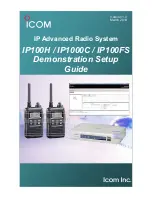
CIRCUIT DESCRIPTION
70-1341/1344/1441/1444
First IF
Mixer output is applied to Q203, which drives L215.
L215 tunes to match the input impedance of the
45
MHz crystal filter XF201 which reject signals
outside the channel bandwidth. L215, L216, and L217
match the input or output of XF201. Q204 amplifies the
first IF signal at least 20dB, and it is coupled to second
IF IC202.
IC202 contains all second IF circuitry, a quadrature
demodulator, and a threshold gate. X201 and circuitry
in IC202 generate second LO injection of 44.545 MHz.
A double-balanced mixer, that cancels both input
signals internally, is utilized so that additional tuned
circuits at its output are not needed. Mixer output
signal of 455 kHz (IC202 pin3 ) is bandpass filtered
further by CF201 and CF202 then superamplified
(100+ dB) by the second IF amplifier/limiter within
IC202 (pin 5).
Demodulation
The quadrature detector in IC202 is another double-
balanced mixer to which limiter output is applied. Its
second input is taken from 455 kHz tank CD201,
which is also fed with limiter output (IC202 pin10).
Frequency deviation from carrier center will cause
phase difference between the two demodulator inputs,
which produces output. Preamplified recovered audio
appears at demodulator output pin 9. C260, C261 and
R254 attenuate signals above 12 kHz.
Audio
Recovered audio from IC202 is routed to op amp
IC401, which controls the amplification level. The
control voltage is fed via the external volume on the
control unit. Output of the gain control IC401 is applied
to the Audio amplifier IC203. Audio amplifier IC203
amplifies the audio signal and drives the speaker.
Squelch
Audio signals at low pass filter are routed through
Squelch Range RV402, which calibrates squelch-
break level when logic unit squelch switch is on. Signal
is amplified and rectified by IC202 to produce a DC
voltage that varies inversely with received RF carrier
level. The DC voltage is input of a level detector within
IC202 and detector output is an open collector that
sinks voltage to logic low when on-channel receiver
input is above the squelch threshold established by
RV402. Level detector output is supplied through NSQ, the
interconnect, to microcomputer input port P41 so that the
microcomputer can take appropriate action.
50 WATT PA SECTION
RF Power Amplifier
A PC-board stripline is used to match Q501-base terminal
to the coax. RF impedance at Q501-collector is
transformed by PC-board stripline to the base terminal of
driver Q503 and the collector of Q503 is transformed to the
base of Q504. RF impedance at the collector of final-stage
Q503 is again transformed by PC stripline. L520—L523
and C551—C555 comprise the harmonic filter. R518 serve
to drain static and other DC potentials from the antenna.
Antenna Gate
In receive mode, PIN-diodes D501, D502 are unbiased.
The RF-signal path from the final-amplifier Q504 is then
severed, and the impedance matching network consisting
of L518, C549, C550, and L518 routes signals from the
antenna to the receiver input through 50
coax at J501.
D501, and D502 are biased on in transmit mode. The
receiver port network is detuned such that it appears as a
high impedance to the antenna, and D501 couples final
amplifier output to the antenna at J501.
Automatic Power Control
A PC stripline ahead of the harmonic filter, and a thin PC
runner adjacent to it, serves as a directional coupler. D505
rectifies a small RF sample that is developed across the
thin runner, producing a DC voltage that increases with RF
power traveling forward into the antenna. This power level
sensing voltage is the inverting input of a differential
amplifier comprised of Q509 and IC501.
The reference voltage is applied to IC901. Differential
amplifier output drives Q507, which is a current source that
feeds primary DC to the collector circuit of predriver Q501.
The feedback loop, from the directional coupler to Q507,
holds RF output power at a constant level which is
determined by IC901.
Thermal Protection
In case of an abnormal temperature rise in PA section,
temperature sensor R538 decreases its resistance. This
temperature sensing voltage is applied to the base of
5 - 4
Summary of Contents for 70-1341
Page 4: ...iv...
Page 7: ...SECTION 1 GENERAL INFORMATION...
Page 8: ...GENERAL INFORMATION 70 1341 1344 1441 1444 NOTES 1 2...
Page 12: ...GENERAL INFORMATION 70 1341 1344 1441 1444 1 6 NOTES...
Page 13: ...SECTION 2 PREPARATION...
Page 14: ...PREPARATION 70 1341 1344 1441 1444 NOTES 2 2...
Page 19: ...SECTION 3 INSTALLATION...
Page 20: ...INSTALLATION 70 1341 1344 1441 1444 NOTES 3 2...
Page 24: ...INSTALLATION 70 1341 1344 1441 1444 NOTES 3 6...
Page 25: ...SECTION 4 SERVICING...
Page 26: ...SERVICING 70 1341 1344 1441 1444 NOTES 4 2...
Page 39: ...SECTION 5 CIRCUIT DESCRIPTION...
Page 40: ...CIRCUIT DESCRIPTION 70 1341 1344 1441 1444 NOTES 5 2...
Page 46: ...CIRCUIT DESCRIPTION 70 1341 1344 1441 1444 5 8 NOTES...
Page 47: ......
Page 48: ......
Page 49: ......
Page 50: ......
Page 51: ......
Page 52: ......
Page 53: ......
Page 54: ......
Page 55: ......
Page 56: ......
Page 57: ......
Page 58: ......
Page 59: ...SECTION 7 PARTS...
















































